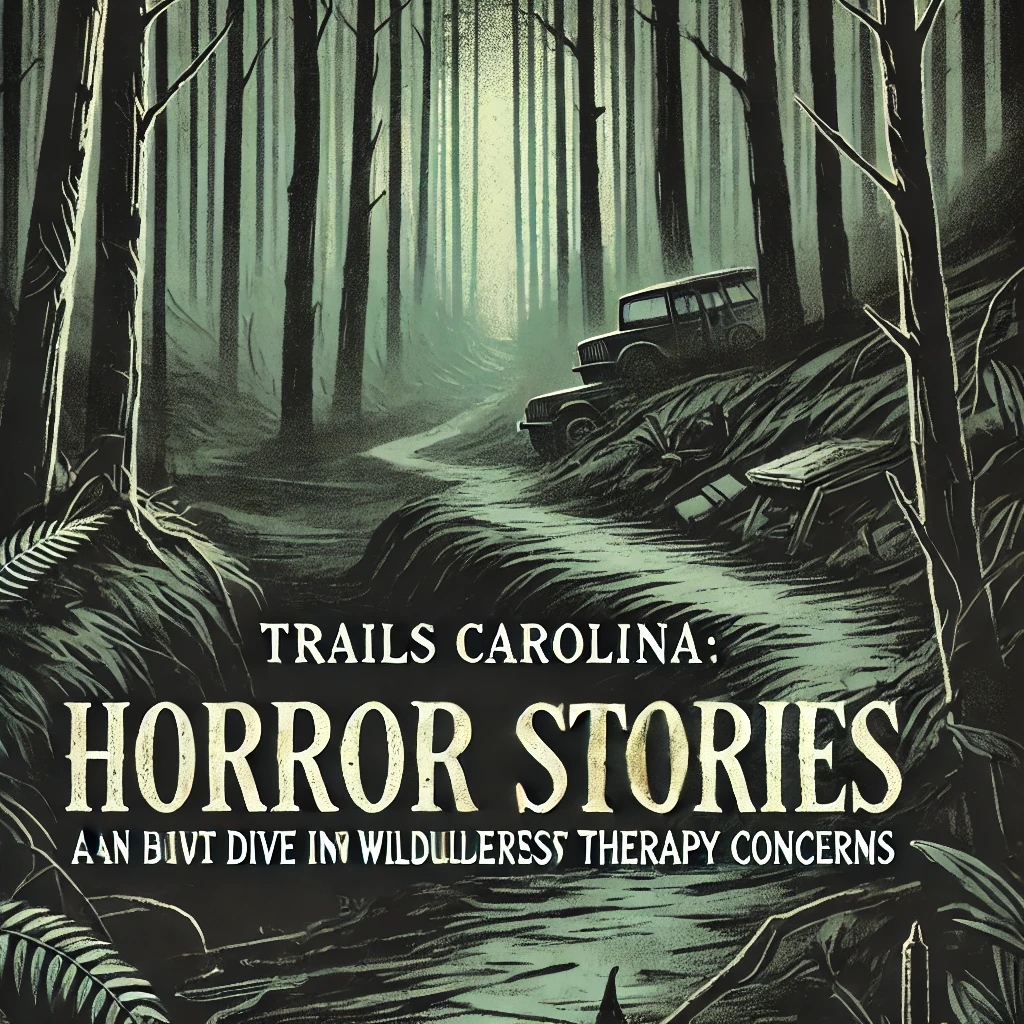Imagine sending your child to a program designed to help them grow, only to uncover a world of disturbing allegations and trauma. This is the reality many families have faced when dealing with Trails Carolina horror stories. In this article, we will dive into the troubling experiences shared by former participants, the controversies surrounding wilderness therapy, and the critical issues that demand attention.
History and Background of Trails Carolina
Trails Carolina was founded in 2008 as a wilderness therapy program aimed at helping adolescents aged 10-17 with emotional and behavioural challenges. The program promises personal growth through a combination of outdoor activities, group therapy, individual counselling, and family therapy. Set in the wilderness of North Carolina, the program markets itself as an escape from modern distractions, where teens can reconnect with themselves and work through their issues.
However, the serene image of wilderness therapy has been overshadowed by unsettling reports of abuse, neglect, and poor treatment, leading to a surge in Trails Carolina horror stories. These stories expose the darker aspects of the program that have raised concerns among families and advocacy groups.
How Wilderness Therapy Works
Wilderness therapy aims to provide troubled teens with an opportunity to grow through structured outdoor activities. The idea is that by removing the distractions of everyday life and immersing young people in nature, they will learn resilience, responsibility, and improved coping mechanisms. Many wilderness therapy programs, including Trails Carolina, combine physical challenges like hiking with therapeutic interventions such as group and individual counselling.
While this approach has worked for some, critics argue that it can be emotionally and physically demanding, especially for adolescents who are already vulnerable. The lack of stringent regulations and oversight within the wilderness therapy industry has allowed cases of mistreatment and negligence to go unchecked.
Unveiling Trails Carolina Horror Stories
The Trails Carolina horror stories that have surfaced paint a troubling picture of the program. Former participants and their families have come forward with accounts of physical and emotional abuse, lack of proper medical care, and a general atmosphere of fear and isolation. These experiences have raised questions about the effectiveness and safety of wilderness therapy, particularly at Trails Carolina.
One of the most disturbing aspects of these stories is the emotional toll they take on participants. Many teens report feeling isolated, scared, and subjected to harsh disciplinary measures that leave long-lasting psychological scars. The intensity of the wilderness environment, combined with inadequate supervision and poorly trained staff, has led to numerous complaints.
Survivor Accounts: Real-Life Experiences
Survivors of Trails Carolina horror stories have shared their experiences through social media platforms and advocacy groups. These accounts often reveal the emotional and physical challenges participants endured during their time in the program. For instance, some former participants recount being forced to hike long distances in extreme weather with minimal support, while others report emotional abuse from staff members.
One participant shared, “It felt more like a prison than a place for healing. We were isolated, and any emotional outbursts were met with harsh punishment. I left Trails Carolina feeling more broken than when I arrived.”
These stories have not only raised awareness of the issues within Trails Carolina but have also sparked broader discussions about the safety and efficacy of wilderness therapy programs in general.
Parent Experiences and Reactions
Parents who sent their children to Trails Carolina with the hope of seeing positive changes have often been met with disappointment and regret. Many families report strained relationships after their child’s participation in the program, and some have even taken legal action against the organisation. The emotional toll on families is immense, as they grapple with the realisation that their trust in the program may have led to further harm.
One parent shared their experience, stating, “We thought Trails Carolina would help our child, but it only made things worse. The lack of communication and transparency from the staff made us feel powerless. Our child came back more anxious and withdrawn than before.”
Long-Term Effects on Participants
The long-term effects of participating in wilderness therapy programs like Trails Carolina can be severe. Many former participants report struggling with anxiety, depression, and symptoms of post-traumatic stress disorder (PTSD) long after leaving the program. The emotional trauma experienced during their time in the program often requires additional therapy and support, undermining the very purpose of wilderness therapy.
For some, the physical challenges of the program, such as hiking and enduring harsh outdoor conditions, have left them with lasting physical injuries, including sprains, fractures, and chronic pain. These injuries, combined with emotional scars, make reintegration into everyday life particularly difficult for former participants.
Staff Perspectives and Program Management Issues
Another troubling aspect of Trails Carolina horror stories is the insight provided by former staff members. Several have come forward to discuss the poor training and inadequate management within the program. Staff turnover is high, with many employees staying less than a year due to the emotional and physical demands of the job. In addition, many staff members are reportedly underqualified, lacking the necessary credentials to handle the complex emotional and psychological needs of the participants.
One former staff member explained, “The training was minimal, and we were expected to manage extreme situations without the proper resources. It was clear that the program was more focused on profit than the well-being of the participants.”
Legal Actions and Investigations
The legal ramifications of the Trails Carolina horror stories cannot be ignored. Over the years, several lawsuits have been filed against the program, alleging negligence, abuse, and failure to provide adequate medical care. Some cases have resulted in settlements, but the legal battles continue, with more families stepping forward to share their experiences and seek justice for the harm their children endured.
Trails Carolina has faced inspections by regulatory bodies, resulting in citations for health and safety violations. These investigations have highlighted the need for more stringent oversight and regulatory reforms within the wilderness therapy industry.
Regulatory Failures and Needed Reforms
One of the key issues highlighted by the Trails Carolina horror stories is the lack of consistent regulation in the wilderness therapy industry. Unlike traditional therapeutic settings, wilderness therapy programs often operate in remote locations with limited oversight, allowing cases of abuse and neglect to go unreported.
There is a growing call for regulatory reforms, including more rigorous staff training requirements, stricter safety protocols, and regular inspections by health and safety authorities. Ensuring the safety and well-being of participants must be the top priority for any wilderness therapy program moving forward.
Alternatives to Wilderness Therapy
For families considering wilderness therapy, it’s important to explore alternatives before making a decision. Residential treatment centres, outpatient therapy, and family counselling are viable options that provide structured care without the potential dangers of an unregulated wilderness environment. These programs often offer better integration of therapy into everyday life and provide more consistent aftercare support, helping teens reintegrate into their families and communities with greater success.
What to Look for in a Safe Wilderness Therapy Program
If you’re still considering wilderness therapy, there are several red flags to watch out for when evaluating a program. High staff turnover, lack of transparency, and a poor safety record are all signs that a program may not prioritise participant well-being. It’s essential to ask detailed questions about staff qualifications, medical protocols, and how the program handles emergencies.
Role of Advocacy Groups and Support Networks
Advocacy groups like Survivors of Institutional Abuse (SIA) and Breaking Code Silence have played a crucial role in amplifying the voices of those affected by the Trails Carolina horror stories. These groups provide a platform for survivors to share their experiences and push for legislative reforms that ensure better protection for future participants.
Conclusion: The Future of Wilderness Therapy Programs
While wilderness therapy can offer valuable growth opportunities, the Trails Carolina horror stories have shown that these programs can also pose serious risks. As the demand for therapeutic interventions grows, it is crucial that regulatory bodies step up to enforce stricter safety standards and that families carefully evaluate programs before enrolling their children. With increased oversight and a focus on transparency, wilderness therapy can become a safer, more effective option for troubled teens.
FAQs:
What is wilderness therapy?
Wilderness therapy is an intervention that uses outdoor activities combined with counselling to help adolescents overcome emotional and behavioural challenges.
How can I ensure a wilderness therapy program is safe?
Research the program’s staff qualifications, safety protocols, and regulatory history. Speak with former participants and their families to get a clearer picture of the program’s operations.
Are there alternatives to wilderness therapy?
Yes, alternatives include residential treatment centres, outpatient therapy, and family counselling, which offer structured environments with less physical risk.


